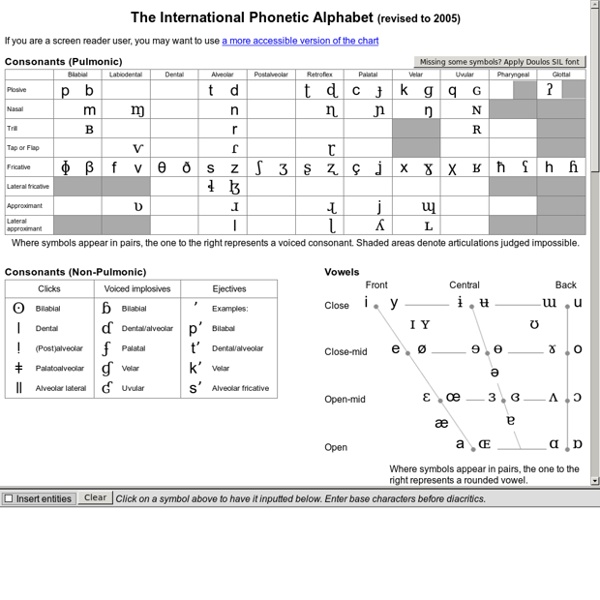



http://westonruter.github.io/ipa-chart/keyboard/
IPA character picker 11 ishida >> apps Character pickers are especially useful for people who don't know a script well, as characters are displayed in ways that aid identification. See the notes for details. Click on characters to create text in the box, then copy & paste to your content. Hide the top of the page. English Pronunciation We use Cisco wireless in all our buildings for convenient and immediate online access. You will need the following for the files below: English Pronunciation/Listening We use the popular Can8 VirtuaLab for all our digital language lab programs. Unit One: TH, as in THINK, BATHROOM, and TEETH.
Obtaining LaTeX LaTeX for the impatient Linux Your system distribution or vendor has probably provided a TeX system including LaTeX. Check your usual software source for a TeX package; otherwise install TeX Live directly. Mac OS X Arpabet Arpabet is a phonetic transcription code developed by Advanced Research Projects Agency (ARPA) as a part of their Speech Understanding Project (1971–1976). It represents each phoneme of General American English with a distinct sequence of ASCII characters. Arpabet has been used in several speech synthesizers, including Computalker for the S-100 (Altair) system, SAM for the Commodore 64, SAY for the Amiga and TextAssist for the PC and Speakeasy from Intelligent Artefacts (see ST_Robotics) which used the Votrax SC01 speech synthesiser IC. It is also used in the CMU Pronouncing Dictionary. Symbols[edit]
Syntactic Theory: 2nd edition Emily M. Bender University of Washington (ebender at u dot washington dot edu) Ivan A. Sag Stanford University (sag at csli dot stanford dot edu) Thomas Wasow Stanford University (wasow at csli dot stanford dot edu) (Back to top of page) To order or to find out more information about the second edition of the Syntactic Theory textbook, by Sag, Wasow and Bender, please go to its CSLI Publications webpage, which is HERE. Errata for Sag, Wasow, and Bender (2003) (Back to top of page)
How to read a spectrogram - Rob Hagiwara Welcome to the Monthly Mystery Spectrogram webzone. These pages are Rob Hagiwara's professional web-space. For personal musings, please see Rob's blog. This is the How To page of the mystery spectrogram webzone. Contents for this page: How do I read a spectrogram? C Sharp (programming language) C♯ is intended to be a simple, modern, general-purpose, object-oriented programming language.[6] Its development team is led by Anders Hejlsberg. The most recent version is C♯ 5.0, which was released on August 15, 2012. The ECMA standard lists these design goals for C#:[6] Due to technical limitations of display (standard fonts, browsers, etc.) and the fact that the sharp symbol (U+266F ♯ music sharp sign (HTML: ♯)) is not present on the standard keyboard, the number sign (U+0023 # number sign (HTML: #)) was chosen to represent the sharp symbol in the written name of the programming language.[8] This convention is reflected in the ECMA-334 C# Language Specification.[6] However, when it is practical to do so (for example, in advertising or in box art[9]), Microsoft uses the intended musical symbol. C# used to have a mascot called Andy (named after Anders Hejlsberg). It was retired on Jan 29, 2004.[25]
Carmel Download (License Agreement) This License Agreement (the "Agreement") is entered, effective this date, by and between University of Southern California, and the individual executing this Agreement below as "Licensee" (hereinafter, the "Licensee"). WHEREAS, USC has developed the Carmel package and related documentation (the "Software"); and WHEREAS, Licensee desires, and USC is willing to grant to Licensee, a license to use the Software in accordance with this Agreement;
Linguistics 566: Introduction to Syntax for Computational Linguistics A core course in UW's Professional Master's in Computational Linguistics Autumn 2013 Course Info Instructor Info Instructor: Emily M.